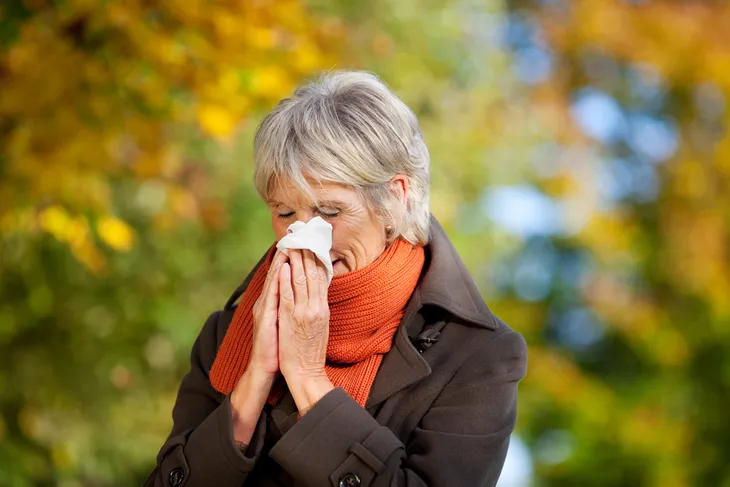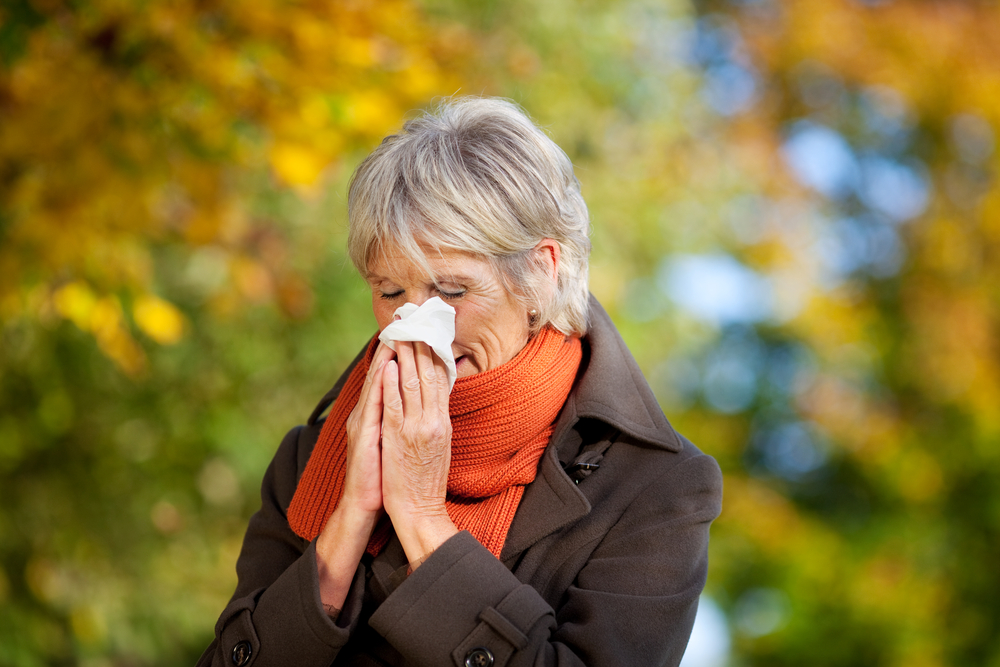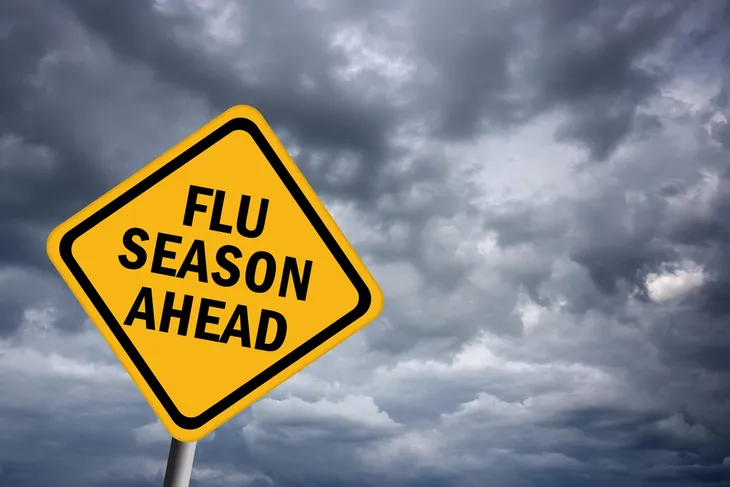- The change in seasons is known to suppress the immune system and increase the likelihood of infection.
- A few common illnesses that peak in the fall include the common cold, seasonal affective disorder, acute bronchitis, and more.
- The best way to avoid these illnesses is to take preventative measures such as eating a balanced diet, avoiding crowded places, and boosting your vitamin D, among others.
There are a variety of illnesses that peak as the weather cools down and we head into the autumn season. The sudden drop in temperature, high winds, varying humidity levels, and increase in rain can affect our bodies significantly. These seasonal changes are known to suppress the immune system which can increase the likelihood of contracting a variety of infections.
The best way to avoid illnesses that peak in the fall is to be prepared with tools on how to prevent them and boost your immune system. Anyone can be affected by changes in weather, but knowing the risks and how to prevent them can help during this time. Follow along for our roundup of 12 illnesses that are known to peak in the fall, as well as a few tips and tricks to prevent them.
Common Cold
The common cold can happen anytime of year, but it tends to peak as the weather cools down and summer fades into fall. The common cold typically lasts anywhere from a few days to a few weeks, and is characterized by symptoms such as a low-grade fever, runny nose, body aches, headache, cough, sneezing, congestion and/or a sore throat.
Since most colds happen in the fall or winter, it’s important to prepare and boost immunities in late August and early September. MayoClinic explains that it’s important to wash your hands frequently throughout the day, eat a balanced diet, keep your stress levels low and avoid spending too much time in crowded places.
 Shutterstock/Prostock-studio
Shutterstock/Prostock-studioSeasonal Allergies
Those who suffer from seasonal allergies know all too well how the change of seasons can affect them. Many who suffer from seasonal allergies notice a peak in symptoms during the fall. WebMD explains that ragweed, mold and dust mites are typically the biggest allergy trigger in the fall. Common symptoms of seasonal allergies include watery and itchy eyes, runny or stuffy nose, itchy sinuses or throat, sneezing, postnasal drainage, headache, snoring, sore throat, congestion, fatigue, and coughing.
When it comes to prevention, a few tips would be to keep your home and car windows closed to avoid unnecessary exposure. Another tip could be to check the daily pollen counts and air quality in your area before spending time outside. It’s also a good practice to take a shower after spending time outside to limit symptoms.
 Shutterstock/stockfour
Shutterstock/stockfourFlu
Flu viruses are another illness that tends to peak in the fall and winter months. According to Cleveland Clinic, the flu, also known as influenza, is a viral infection that attacks your nose, throat and lungs. In the U.S., flu season typically begins in October and can run until May. The strains of the flu can look different each year and vary from mild to severe. Common symptoms of the flu include diarrhea, fatigue, nausea, body aches, congestion, chills, fever, headache, cough, chest tightness and/or sore throat.
Healthline explains that a few effective methods to prevent the flu include avoiding large crowds and washing your hands regularly. It may also be helpful to strengthen your immune system by maintaining regular exercise and eating a balanced diet. You could also consider receiving an annual flu vaccination to reduce your risk of contracting the flu or reducing the severity and duration of your illness if you do get the flu.
Sore Throat
It’s more likely you will experience a sore throat as the seasons change heading into fall. Your symptoms may begin with a dry or itchy throat, and later transpire into a full blown sore throat. According to WebMD, you may also experience symptoms such as a hoarse voice, trouble swallowing, swollen glands in neck, chills, loss of appetite, itchy eyes and body aches. A sore throat is typically also a symptom of seasonal allergies, common cold, and the flu.
If you’re hoping to prevent a sore throat heading into the colder months, there are a few tips and tricks to keep in mind. Be sure to wash your hands often and cover your mouth, and avoid sharing drinks, foods or utensils with others. It may also be helpful to ensure you’re drinking enough water, and you could consider adding a humidifier to your room to keep your throat hydrated.
 Shutterstock/puhhha
Shutterstock/puhhhaVitamin D Deficiency
Vitamin D is an essential vitamin in maintaining both our physical and mental health. According to MayoClinic, vitamin D helps to ensure proper growth and strength for bones, and plays an important role for your nervous system, musculoskeletal system and immune system. A major source of vitamin D is through the food you eat and through sunlight. Since there is typically less sunlight in the colder months, it’s common that many people experience a vitamin D deficiency. Symptoms of a vitamin D deficiency include getting sick often, fatigue, bone and back pain, hair loss, and depression.
According to WebMD, the best way to prevent a vitamin D deficiency is to spend time outdoors each day and to ensure you are eating a balanced diet rich in nutrients. You could also consider adding a vitamin D supplement into your routine, or incorporating a UV lamp into your home to boost vitamin D.
 Shutterstock/New Africa
Shutterstock/New AfricaArthritis
Arthritis is a condition where the joints become tender and swell. According to Healthline, arthritis can be felt year-round, but those who suffer from the condition have often noted that cool and damp weather may cause their symptoms to flare up. Symptoms of arthritis include joint pain, fatigue, as well as swelling, stiffness and tenderness in joints.
If you’re hoping to prevent an arthritis flare-up as the weather turns, there are a few preventative measures you can take. Be sure to eat a healthy, well-rounded diet complete with fruits, vegetables, fish and nuts. It’s also important to exercise regularly to keep your joints flexible and to control your body weight to avoid putting strain on your joints.
Asthma
Another condition that often peaks in the fall is asthma. According to Family Care Centers Medical Group, cold and damp weather is known to increase the risk of asthma attacks by drying out the airways. Other common illnesses, such as the common cold and flu, are also triggers that can increase asthma flare-ups during the fall. A few symptoms of cold-induced asthma include tightness in the chest, wheezing, coughing, shortness of breath and difficult speaking and sleeping.
It’s possible to limit the risk of having an asthma attack as the weather turns by taking preventative measures. A few to consider include staying away from asthma triggers, and quitting smoking or staying in smoke-free environments. It may also be helpful to monitor your breathing and using a quick-relief inhaler if you begin to experience difficulty breathing.
 Shutterstock/Dragana Gordic
Shutterstock/Dragana GordicNorovirus
Norovirus is an illness that can occur year-round, but tends to be more likely in the fall and winter months. WebMD explains that norovirus is one of the most common causes of acute gastroenteritis. Norovirus causes stomach inflammation and is extremely contagious. It can be transferred from person to person contact or through contaminated foods such as seafood. Common symptoms of norovirus include nausea, vomiting, diarrhea, abdominal pain, and muscle pain.
To prevent contracting norovirus heading into fall, be sure to wash your hands often and thoroughly. It’s also important to avoid preparing foods or caring for others when you are sick to avoid the spread. Be sure to clean your bathrooms with disinfectants, and cook your seafood thoroughly.
Acute Ear Infections
According to Family Care Centers Medical Groupe Inc, ear infections are more likely to occur in the fall than any other season. Ear infections are caused by inflammation or a virus in the middle ear. Ear infections are typically more common in children, and can also be the result of other illnesses such as the common cold, allergies and the flu. Typical symptoms of acute ear infections include ear pain, loss of hearing, vomiting, diarrhea, dizziness, and feelings of fullness or tenderness in the ear.
Some tips to avoid and prevent ear infections is to stay in smoke-free environments, avoid putting cotton swabs or other objects into the ear, and to wash hands thoroughly. It’s also important to teach your children proper hygienic practices to help them avoid contracting an ear infection.
 Shutterstock/Rido
Shutterstock/RidoAcute Bronchitis
Acute bronchitis is another illness that tends to peak in the fall. MayoClinic explains that acute bronchitis is the inflammation of the lining of the bronchial tubes that carry air into the lungs. Acute bronchitis is typically triggered by a virus and often occurs after the flu, a sore throat or the common cold. A few common symptoms of acute bronchitis include congestion, chest tightness, wheezing, shortness of breath, body aches, sore throat and a cough that develops mucus.
It’s possible to avoid acute bronchitis by taking preventative measures. Some of these tactics include quitting smoking and staying in smoke-free areas, staying away from irritants to the throat and lungs, regularly washing hands and disinfecting commonly touched surfaces such as doorknobs and countertops.
Sinusitis
Sinusitis is an inflammation or swelling of the tissue lining the sinuses, according to WebMD. This illness tends to be more common when the weather cools down because the most common causes of sinusitis are already prevalent this time of year, such as allergies, cold and the flu. Symptoms of sinusitis include tenderness around the eyes and bridge of nose, post nasal drip, teeth pain, headache, discoloured nasal discharge, fever and nasal congestion.
Some preventative tips to avoid sinusitis this fall include drinking plenty of fluids to keep your nasal secretions thin, managing your allergies, avoiding air travel and keeping your nose moist with saline sprays.
 Shutterstock/ALPA PROD
Shutterstock/ALPA PRODSeasonal Affective Disorder
Aside from physical illness, another common disorder that peaks in the fall is seasonal affective disorder. MayoClinic explains that seasonal affective disorder, also known as SAD, is a type of depression that is related to changes in season. It’s a mood disorder that affects many people throughout the fall and winter. Common symptoms of SAD include sadness, fatigue, weight gain, difficulty concentrating, low energy and feelings of hopelessness.
If you’re someone who is prone to seasonal affective disorder, it’s important to practice extra self care as the seasons change. Some ways to be proactive heading into fall is to incorporate regular physical exercise into your routine and to get outside often to boost vitamin D. You could also consider adding a vitamin D supplement to your routine.
 Shutterstock/Prostock-studio
Shutterstock/Prostock-studio






